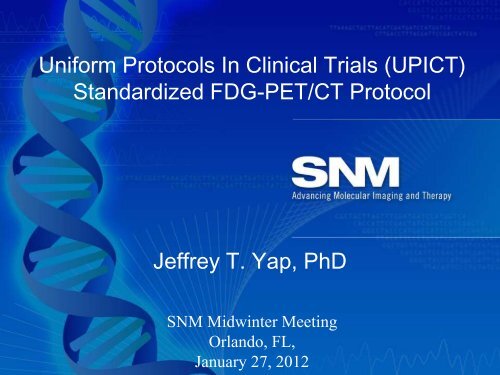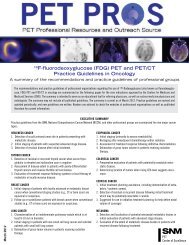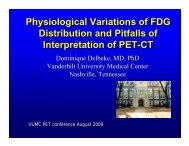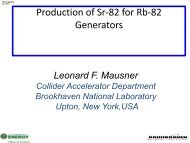Uniform Protocols In Clinical Trials (UPICT) Standardized FDG-PET ...
Uniform Protocols In Clinical Trials (UPICT) Standardized FDG-PET ...
Uniform Protocols In Clinical Trials (UPICT) Standardized FDG-PET ...
You also want an ePaper? Increase the reach of your titles
YUMPU automatically turns print PDFs into web optimized ePapers that Google loves.
<strong>Uniform</strong> <strong>Protocols</strong> <strong>In</strong> <strong>Clinical</strong> <strong>Trials</strong> (<strong>UPICT</strong>)<br />
<strong>Standardized</strong> <strong>FDG</strong>-<strong>PET</strong>/CT Protocol<br />
Jeffrey T. Yap, PhD<br />
SNM Midwinter Meeting<br />
Orlando, FL,<br />
January 27, 2012
• Grant Funding<br />
– Bayer<br />
– BristolMyersSquibb<br />
– Pfizer<br />
– Toshiba<br />
• Consultant<br />
– IBA Molecular<br />
Disclosure<br />
• Presentation may include<br />
unlabeled/unapproved use of <strong>FDG</strong>
CTSA Imaging Working Group<br />
• <strong>In</strong>itiated in 2008 to coordinate imaging efforts<br />
across centers with <strong>Clinical</strong> Translational<br />
Science Awards (CTSA)<br />
• Sponsored/coordinated by RSNA<br />
• <strong>In</strong>dustry participation from pharma, imaging<br />
CROs<br />
• Subgroups<br />
– Cores/Education<br />
– Imaging informatics<br />
– <strong>UPICT</strong>/Imaging in <strong>Clinical</strong> <strong>Trials</strong>
<strong>UPICT</strong> Goals<br />
• Reduce variance related to imaging in the<br />
conduct of clinical trials<br />
– Improve the detection of differences due to study intervention<br />
– support optimization and validation of imaging biomarkers<br />
• Develop generic template and library of<br />
specific protocols
<strong>UPICT</strong> History<br />
• Bi-monthly calls and annual working<br />
group meetings at RSNA starting in 2008<br />
• CTSA/IRAT meeting in 2009<br />
– Generic template<br />
– <strong>FDG</strong>-<strong>PET</strong> oncology, vCT, Alzheimer’s <strong>PET</strong><br />
• <strong>FDG</strong>-<strong>PET</strong> writing group<br />
– Weekly calls since early 2010<br />
– Coordination with SNM global harmonization summit (June 2010)
<strong>UPICT</strong> <strong>FDG</strong>-<strong>PET</strong> writing group<br />
Ronald Boellaard<br />
Paul Christian<br />
Gary Dorfman (Chair) John Sunderland<br />
Michael Graham<br />
Otto Hoekstra<br />
John Hoffman<br />
Paul Kinahan<br />
Eric Perlman<br />
Richard Wahl<br />
Jeffrey Yap
SNM <strong>FDG</strong>-<strong>PET</strong> Global Harmonization (6/2010)<br />
Ronald Boellaard<br />
Andrew Buckler<br />
Michael Casey<br />
Paul Christian<br />
Pat Cole<br />
Dominique Delbeke<br />
Michael Graham<br />
Nathan Hall<br />
John Hoffman<br />
Michael Knopp<br />
Karen Kurdziel<br />
Chieko Kurihara-Saio<br />
David Mankoff, MD<br />
Paul Marsden<br />
George Mills<br />
James Mountz<br />
Jin Chul Paeng<br />
Eric Perlman<br />
Lucy Pike<br />
Andrew Scott<br />
Lingxiong Shao<br />
Daniel Sullivan<br />
Richard Wahl<br />
Wolfgang Weber<br />
Jeffrey Yap
<strong>UPICT</strong> template headings<br />
0. Executive Summary<br />
1. Context of the Imaging Protocol within the<br />
<strong>Clinical</strong> Trial<br />
2. Site Selection, Qualification and Training<br />
3. Subject Scheduling<br />
4. Subject Preparation<br />
5. Imaging-related Substance Preparation and<br />
Administration<br />
6. <strong>In</strong>dividual Subject Imaging-related Quality<br />
Control
<strong>UPICT</strong> template headings<br />
8. Imaging Procedure<br />
9. Image Post-processing<br />
10. Image Analysis<br />
11. Image <strong>In</strong>terpretation<br />
12. Archival and Distribution of Data<br />
13. Quality Control<br />
14. Imaging-associated Risks and Risk<br />
Management
<strong>UPICT</strong> Appendices<br />
A. Acknowledgements and Attributions<br />
B. Background <strong>In</strong>formation<br />
C. Conventions and Definitions<br />
D. Documents included in the imaging protocol<br />
(e.g., CRFs)<br />
E. Associated Documents (derived from the<br />
imaging protocol or supportive of the imaging<br />
protocol)<br />
F. Model-specific <strong>In</strong>structions and Parameters
<strong>UPICT</strong> Framework<br />
• Librarian/Editor function<br />
• Collection and extraction of available<br />
resources into <strong>UPICT</strong> template<br />
• Consolidated and Consensus statements<br />
• Bullseye approach to compliance<br />
– Acceptable<br />
– Target<br />
– Ideal
Wikipedia of <strong>FDG</strong>-<strong>PET</strong> procedures?<br />
• Many contributors and authors<br />
• Citation for sources<br />
• Bibliography, appendices<br />
• Comprehensive, specific, detailed<br />
– 14 page template<br />
– 66 pages excluding references, appendices<br />
• Will be open for public comment/revisions<br />
• Alzheimer’s and FLT protocols underway
Accuracy ✔<br />
Sensitivity ✔<br />
Specificity ✔<br />
You have exceeded the count limit by 27,666 words<br />
0. Executive Summary<br />
“This <strong>UPICT</strong> Protocol is intended to guide the<br />
performance of whole-body <strong>FDG</strong>-<strong>PET</strong>/CT within the<br />
context of single- and multi-center clinical trials of<br />
oncologic therapies by providing acceptable (minimum),<br />
target, and ideal standards for all phases of the imaging<br />
examination as defined by the <strong>UPICT</strong> Template (ref) with<br />
the aim of minimizing intra- and inter-subject, intra- and<br />
inter-platform, inter-examination, and inter-institutional<br />
variability of primary and/or derived data that might be<br />
attributable to factors other than the index intervention<br />
under investigation.”
1. Context of the Imaging Protocol within the <strong>Clinical</strong> Trial<br />
1.1. Utilities and Endpoints of the Imaging Protocol<br />
1.2. Timing of Imaging within the <strong>Clinical</strong> Trial Calendar<br />
1.3. Management of Pre-enrollment Imaging<br />
1.4. Management of Protocol Imaging Performed Off-schedule<br />
1.5. Management of Protocol Imaging Performed Offspecification<br />
1.6. Management of Off-protocol Imaging<br />
1.7. Subject Selection Criteria Related to Imaging<br />
1.7.1. Relative Contraindications and Remediations<br />
1.7.2. Absolute Contraindications and Alternatives<br />
1.7.3. Imaging-specific <strong>In</strong>clusion Criteria
1.7.2 Absolute Contraindications and Alternatives<br />
Quantitative Primary imaging endpoint: “it is<br />
suggested that diabetic subjects unable to<br />
achieve a fasting blood glucose level (without the<br />
use of short-acting / regular insulin within four<br />
hours preceding the <strong>FDG</strong>-<strong>PET</strong>/CT study) of
1.7.2 Absolute Contraindications and Alternatives<br />
Qualitative or Secondary imaging endpoint: “it is<br />
suggested that the trial explicitly state whether<br />
subjects unable to achieve a fasting blood<br />
glucose level of
3. Subject Scheduling<br />
“For known diabetic subjects with anticipated<br />
fasting blood glucose measurements for the day<br />
of the examination between 126 mg/dl and<br />
200mg/dl, the following scheduling<br />
recommendations apply:<br />
– Ideal / Target: Type I and Type II diabetic subjects should be<br />
scanned early in the morning before the first meal, and doses of<br />
insulin and/or hypoglycemic medication should be withheld if<br />
glucose levels remain in the acceptable range. This should be<br />
established from morning blood glucose levels prior to the study.”
3. Subject Scheduling<br />
– “Acceptable: Type I and Type II diabetic subjects, who cannot reliably attain<br />
acceptable glucose levels early in the morning, should be scheduled for late<br />
morning, and should eat a normal breakfast at 7 am and take their normal<br />
morning diabetic drugs; then fast for at least 4 hours till exam. This strategy is<br />
acceptable only for<br />
• Non-quantitative <strong>PET</strong>/CT, or<br />
• Endpoints that are not for the primary aim, or<br />
• Subjects whose baseline study was performed with a FBG
5.3 Timing, Subject Activity Level, and Factors<br />
Relevant to <strong>In</strong>itiation of Image Data Acquisition<br />
• Consolidated statement on <strong>FDG</strong> uptake period:<br />
“The suggested consensus time (from all references)<br />
between <strong>FDG</strong> administration and scan acquisition<br />
is 60 minutes based on historical use of this test;<br />
assuming this is the target window, an acceptable<br />
window is often cited as +/- 5 minutes (55-65<br />
minutes). Two references (NCI and ACRIN) allow<br />
the acceptable window to be +/- 10 minutes (50-70<br />
minutes), which is considered the absolute<br />
minimum of acceptability.”
5.3 Timing, Subject Activity Level, and Factors<br />
Relevant to <strong>In</strong>itiation of Image Data Acquisition<br />
• Consolidated statement on <strong>FDG</strong> uptake period:<br />
“However, on the basis of the SNM harmonization<br />
summit while the “target” tracer uptake time is<br />
60 minutes, the “acceptable” window is from 55<br />
to 75 minutes so as to ensure that imaging does<br />
not begin prematurely so as to allow adequate<br />
tumor uptake of <strong>FDG</strong> and to account for the<br />
practicality of work flow which often does not<br />
accommodate imaging at exactly 60 minutes<br />
after <strong>FDG</strong> injection.”
12.1.1 Quality Control Procedures
Appendix G: Vendor/Model Specific QC
Appendix G: Vendor/Model Specific QC
Appendix G: Vendor/Model Specific QC
Resources<br />
• http://wiki.ctsa-imaging.org








